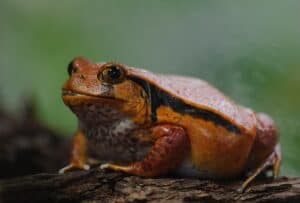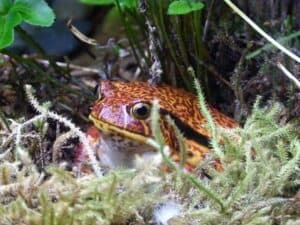
If you are looking for a tomato frog care guide this is a good place to start. In this article, we will discuss just about everything you need to know about owning a tomato frog. Tomato frogs can make excellent pets but there are some things you need to know before purchasing one.
Frogs, in general, are some of my favorite critters you can own as a pet. However, if you are looking for something you can handle regularly then frogs might not be the best choice. Amphibians do not like to be handled as much as many other animals do.
What truly makes a frog a great pet is that they are very beautiful creatures. So if you are looking for something that looks cool but does not require too much handling then a tomato frog might be the perfect fit. Down below we will cover just about every topic related to tomato frog care, but first, let’s just do a quick overview of the tomato frog.
Tomato Frog Overview
Tomato frogs are beautiful red-orange colored frogs native to the island of Madagascar. One look at these beautiful animals and you know why they are called tomato frogs. During the day tomato frogs like to spend most of their time burrowed in the mud or under a pile of leaves. Since tomato frogs are nocturnal they will be most active during the night.
When properly cared for tomato frogs make excellent pets. However, like most frog species, tomato frogs do not like to be held. When stressed tomato frogs excrete a white liquid to deter predators. However, this liquid can also cause allergic reactions to humans. Of course, if you must handle your frog make sure to thoroughly wash your hands after and avoid any contact with your face and eyes.
In the same way, the oils from our skin and residue from our hygiene products can be harmful to your frog as well. So make sure your hands are properly cleaned before handling your tomato frog. Amphibians in general are not the best pets if you are looking for something to handle often. This is due to the sensitive nature of their skin.
However, like many other frog species, tomato frogs are beautiful animals and can make excellent pets for the right owners. They do not require as much space as do many other exotic pets and are relatively easy to care for.
Tomato Frog Size And Lifespan
Generally speaking, tomato frogs average anywhere from 2-4 inches long. Males are typically smaller and will seldom grow past 2.5 inches. While female tomato frogs typically will grow up to about 4 inches long.
Though they have been known to live up to 10 years long, anywhere from 5-8 years is much more likely. This is slightly lower than many other popular frog species. The white’s tree frog, for example, has been know to live up to 25 years.
What Do Tomato Frogs Eat?
When it comes to tomato frog care, one of the most important things to understand what to feed your tomato frog. Tomato frogs can eat a variety of foods. Such as crickets, earthworms, mealworms, guppies, minnows, are some common examples. Large adult tomato frogs can even be fed the occasional pinky mouse. Young tomato frogs should be fed about twice daily with small crickets and other small insects. As a rule of thumb, feed your tomato frog foods smaller than the space between their eyes.
As your frog gets closer to adulthood you can transition them to once a day feeding. When fully grown, however, they can be fed once every two days. Feed your tomato frog at night while they are most active. Adults can eat a fair bit of food up to 10 adult crickets is not uncommon. Crickets are a great staple for a tomato frog’s diet.
Watering
Provide a clean shallow watering bowl at all times. The watering bowl should be buried in the substrate to allow easy access in and out of the watering bowl. Fill the watering bowl only up to half of the height of your tomato frog with non-chlorinated water.
Ironically tomato frogs are not the best swimmers. It is very important that your frog’s watering bowl is not so deep that it cannot easily get out. Drowning is very common in caring for frogs as crazy as that sounds. The bowl should be at least twice as long as your tomato frog and cleaned on a regular basis.
Vitamins And Supplementation For Tomato Frogs
For optimal health, you are going to want to purchase a calcium and multivitamin/mineral supplement for your tomato frog. Simply dust crickets, mealworms, etc with a good calcium and multivitamin/mineral supplement.
Calcium supplementation is very important for the health of your tomato frog. Calcium is required for adequate bone health. In addition, D3 is also very important, however, your tomato frog will get most of this with proper lighting.
For this reason, it is recommended to use calcium without D3 three to four times per week. Then use calcium with D3 only once per week. In addition, I would recommend dusting its food with a multivitamin once per week as well.
- Dust with calcium every other feeding
- Dust with calcium plus D3 once per week
- Dust with multivitamin once per week
Crickets should also be gut-loaded with nutritious cricket food to prevent any deficiencies. Do this just prior to feeding your tomato frog. It is important to take that extra step to help ensure the health of your tomato frog.
Setting Up Your Tomato Frog’s Enclosure

Another very important aspect of tomato frog care is proper housing. Having the right setup is essential for the long-term health of your tomato frog. I would recommend having your tomato frogs cage set-up before bringing it home. There are many things you can do to make your tomato frogs cage look great but let’s just start with the basics.
Enclosure Size
A 15-20 gallon tank would be ideal for housing one to three adult tomato frogs. Since tomato frogs spend most of their time burrowed in the ground, it is more important that the cage is long or wide as opposed to tall.
Tomato frogs are ground dwellers so they do not require the space to climb as many other frog species do. Make sure your enclosure has a screen top and that your frog cannot escape.
Bedding
Next, you are going to want to figure out what kind of bedding you are going to use. There are a number of options to choose from but here are a few options. For one, you can have a base made of gravel. Gravel provides great drainage but will need to be layered with either frog moss or coconut fiber substrate. This will help with retaining the correct humidity levels for your tomato frog.
You can also just use coconut fiber substrate as the base and add a bit of frog moss on top of that. Your bedding should be at least 3 inches high as your frog is going to want to burrow in the bedding. After all, this is where your frog will spend the majority of its time.
Once you lay down your coconut fiber substrate you want to then lay out the moss. I like Frog Moss and New Zealand Sphagnum Moss by the company Zoo Med. Soaking the moss before laying it out can bring a bit of life back into the moss. Place moss around the cage as desired. There are many other options but these two are simple and work great.
Decor
After that, you are going to want to decorate your tomato frogs cage with places for it to hide. Real and artificial plants make great hiding places and can make your cage look amazing. Good examples of live plants that you can use are devil’s ivy, spider plants, and bromeliads.
In addition, you can place a few cork bark flats around the cage as an extra hiding place for your tomato frog. There are many other options that make good hiding places for your tomato frog that you can find online or your local pet store. As long as your frog has a place to hide you should be in the clear.
Ideal Temperature And Humidity For Tomato Frog Care
The ideal daytime temperature for a tomato frog is about 75-85 degrees Fahrenheit. Ideally, you want one side of the cage closer to 75 and the other side closer to 82-85 degrees during the day. At night time temperatures should fall down to about 70-75 degrees Fahrenheit. I recommend purchasing either an under the tank heating pad or a mild basking light. Place either of these on the opposite side of the tank as their watering bowl.
You can use a good thermometer/hygrometer to monitor the temperature and humidity. A good thermostat you help maintain your desired temperature. In addition, daily misting of your tomato frog’s cage is very important for maintaining a proper humidity level of 70-80 percent.
Lighting
UVA lighting is important for their appetite and emotional state. However, it is important that they are able to hide from this light if they need to. Make sure to keep their day and night cycle as consistent as possible. A photoperiod of roughly about 12 hours during the summer and 8-10 hours during the winter is recommended.
Recommended Tomato Frog Enclosure Checklist
- Exo Terra Short All Glass Terrarium 24x18x12
- Zoo Med frog moss
- New Zealand Sphagnum Moss
- Zoo Med Eco Earth Loose Coconut Fiber Substrate
- Cork bark flats
- Watering dish
- Tank decor for additional hiding
- Fluker’s Digital Thermometer/ Hygrometer
- Zoo Med Repti Therm Under Tank Heater
- Thermostat
- Exo Terra Repti-Glo 2.0 Compact Fluorescent Full Spectrum Terrarium Lamp
Are Tomato Frogs Easy To Care For As Beginners?
Though I do believe that tomato frogs make good pets, they are not my first choice for a first-time frog owner. Caring for a tomato frog is a bit more complicated than caring for many other species of frogs you could choose from.
That said if you really are interested in getting a tomato frog then I don’t want to encourage you against it. If you do your proper study and get a basic understanding of tomato frogs they are not a bad choice even if it is your first frog.
One thing to understand about frogs and most amphibians is that they do not particularly like to be held. This goes for just about every frog but some can tolerate handling more than others can. My number one recommendation for a first-time frog owner is a white’s tree frog.
Even white’s tree frogs are not the best pet option if you want to handle your pet often. This goes for every amphibian because their skin is sensitive to human touch. This is due to the oils and other chemicals on our skin. So make sure to properly clean your hands before handling them.
In Conclusion
When properly cared for tomato frogs can make great pets for many years. They are a good option for a first time exotic pet owner. However, like previously stated these beautiful animals are not the best choice if you are looking for a pet to handle regularly.
This goes for just about every frog species but some are better choices than others. Tomato frogs can be great pets but you need to understand what to expect from owning one. Hopefully, you have enjoyed this tomato frog care guide. We plan on making plenty of care sheets for all of your favorite reptiles and amphibians.
